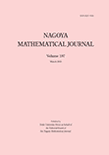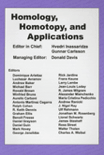
Categories and General Algebraic Structures with Applications
Scope & Guideline
Elevating Mathematical Discourse and Discovery
Introduction
Aims and Scopes
- Algebraic Structures:
The journal emphasizes the study of diverse algebraic structures such as semigroups, lattices, and groups, exploring their properties and interrelations. - Category Theory Applications:
Research often integrates category theory, providing a framework for understanding algebraic structures and their morphisms, enhancing theoretical and practical applications. - Topological and Order-Theoretic Aspects:
A consistent focus on the interplay between algebraic structures and topology or order theory, examining how these domains inform each other. - Interdisciplinary Approaches:
The journal encourages interdisciplinary research that connects algebraic concepts with other areas of mathematics, such as logic, topology, and combinatorics. - Innovative Methodologies:
A commitment to new methodologies in the study of algebraic structures, including advanced techniques in homotopy theory, duality, and categorical constructs.
Trending and Emerging
- Advanced Homotopy Theory:
An increasing number of papers are delving into homotopy theory, reflecting its growing importance in understanding complex algebraic structures and their interrelations. - Quantum Algebra and Topology:
Emerging research in quantum algebra, particularly in relation to ribbon categories and quantum determinants, showcases the journal's engagement with modern theoretical physics and algebra. - Categorical Dualities and Extensions:
There is a notable trend towards exploring dualities and extensions within categorical frameworks, indicating a deeper investigation into the foundational aspects of category theory. - Applications of Algebraic Structures in Other Fields:
Research that applies algebraic structures to areas such as computer science, logic, and combinatorial mathematics is on the rise, illustrating the relevance of algebra in solving practical problems. - Complexity in Algebraic Models:
Recent trends show a focus on complex algebraic models, including cubical structures and multi-ring theories, which suggests a shift towards more intricate systems within algebra.
Declining or Waning
- Classical Algebraic Structures:
Traditional studies focusing solely on classical algebraic structures such as groups and rings are becoming less frequent, possibly due to the increasing interest in more complex and higher-dimensional structures. - Basic Topological Properties:
Research centered on elementary topological properties of spaces related to algebraic structures is waning, as more researchers are exploring deeper, more abstract relationships. - Elementary Category Theory:
Basic discussions and applications of elementary category theory are decreasing, as the field is moving towards more sophisticated applications and developments.
Similar Journals

SEMIGROUP FORUM
Illuminating the Path of Algebra and Number TheorySEMIGROUP FORUM, published by SPRINGER, is a preeminent journal based in the United States that serves as a vital platform for scholarly discourse in the field of algebra and number theory. With an impressive history stretching from 1970 to 2024, this journal has established itself as a key resource for researchers and practitioners alike, boasting a 2023 Q1 ranking in its category. The journal is recognized globally, with its ISSN 0037-1912 and E-ISSN 1432-2137 ensuring broad accessibility. Although it does not currently offer open access options, SEMIGROUP FORUM continues to engage a dedicated readership through its rigorous peer-reviewed articles that enhance the understanding of semigroups and their applications. As a beacon in the mathematical community, it ranks 50th out of 119 in the Scopus Mathematics category, reflecting its importance and impact in academia. Researchers, professionals, and students seeking to deepen their knowledge in algebra and number theory will find SEMIGROUP FORUM an essential resource for high-quality research and innovative discussions.

Annals of K-Theory
Elevating Mathematical Discourse Through Rigorous ExplorationAnnals of K-Theory, published by Mathematical Science Publishers, is an esteemed academic journal that serves as a vital platform for advancing research in the fields of analysis, geometry, and topology. Since its inception in 2016, the journal has successfully merged rigorous mathematical exploration with practical application, catering to a diverse audience of researchers, professionals, and students. With an impressive track record as a Q2 journal in Analysis and Geometry and Topology, and achieving a Q1 ranking in Assessment and Diagnosis in 2023, Annals of K-Theory continues to be recognized for its significant contributions to the mathematical sciences community. Although currently not open access, the journal provides relevant and accessible content that encourages rigorous dialogue and collaboration among mathematicians. As indicated by its Scopus rankings, it holds a commendable position within its field, demonstrating a commitment to quality research that pushes the boundaries of mathematical knowledge and application.

ALGEBRA UNIVERSALIS
Pioneering Research in Algebra and BeyondALGEBRA UNIVERSALIS is a prestigious academic journal published by Springer Basel AG, dedicated to the exploration and advancement of mathematical research, particularly within the realms of algebra, number theory, and logic. Established in 1971, this journal continues to provide a platform for innovative research and discourse, contributing significantly to its fields of study over more than five decades. With its current classification in the Q2 quartile for both Algebra and Number Theory and Logic, ALGEBRA UNIVERSALIS ranks prominently within the mathematical community. Although it is not an open-access journal, it offers numerous subscription options for individuals and institutions seeking to stay current with the latest developments and findings. The journal’s commitment to quality research makes it an essential resource for researchers, professionals, and students aiming to deepen their understanding and knowledge of advanced mathematical theories and methodologies.

Algebra And Discrete Mathematics
Fostering Scholarly Discourse in Algebra and Discrete MathematicsAlgebra And Discrete Mathematics, published by LUHANSK TARAS SHEVCHENKO NATIONAL UNIVERSITY, is a pivotal academic journal dedicated to exploring the realms of algebra and discrete mathematics. Since its inception in 2012, this journal has contributed significantly to the mathematical community, catering to researchers, professionals, and students interested in advancing their understanding of both classical and contemporary mathematical theories. With categories placed in Q4 in Algebra and Number Theory and Q3 in Discrete Mathematics and Combinatorics, and rankings that place it among various domains with percentiles reflecting its niche status, the journal offers a platform for innovative and high-quality research. While the journal is currently not open access, it maintains a robust academic presence, and its continuous publication until 2024 ensures a steady stream of scholarly discourse. Researchers and academics keen on disseminating their findings or keeping abreast of the latest developments in these mathematical fields will find valuable insights and diverse methodologies within its pages.

NAGOYA MATHEMATICAL JOURNAL
Connecting Scholars to Cutting-Edge Mathematical InsightsNAGOA MATHEMATICAL JOURNAL, published by Cambridge University Press, is a prestigious journal that has been at the forefront of advancing mathematical scholarship since its inception in 1950. With an ISSN of 0027-7630 and an E-ISSN of 2152-6842, this journal has gained recognition for its high-quality research contributions in the field of mathematics, achieving a Q1 classification in Mathematics (miscellaneous) as of 2023. The journal’s impact is further reflected in its Scopus rank of #164 out of 399 in the General Mathematics category, positioning it within the 59th percentile of its peers. Scholars, researchers, and students can access a range of innovative mathematical studies that explore diverse topics, fostering a vibrant dialogue within the mathematical community. By catering to a global audience, the NAGOYA MATHEMATICAL JOURNAL continues to play a critical role in shaping contemporary mathematical discourse and research.

Homology Homotopy and Applications
Advancing the Boundaries of Algebraic TopologyHomology Homotopy and Applications is a prestigious peer-reviewed journal published by INT PRESS BOSTON, INC, dedicated to advancing the field of mathematics, particularly within the realms of algebraic topology, homological algebra, and their applications. With an impressive Q1 classification in the mathematics category for the year 2023, this journal serves as a crucial platform for researchers, professionals, and students aiming to disseminate their findings in a rapidly evolving discipline. Although open access options are not currently available, the journal retains significant value with its rigorous selection process and high-impact studies. The journal invites submissions that explore theoretical developments as well as practical applications that bridge homology and homotopy theories, thus contributing to the broader scientific community from its base in the United States. With convergence covering years from 2001 to 2024, Homology Homotopy and Applications continues to be a vital resource for fresh insights and groundbreaking research in mathematical sciences.

Archivum Mathematicum
Exploring the Frontiers of Mathematical KnowledgeArchivum Mathematicum is an open-access journal dedicated to the broad spectrum of Mathematics, published by Masaryk University, Faculty of Science in the Czech Republic. Since its inception in 1965, this journal has provided a platform for the dissemination of research and advancements within the mathematical sciences. It spans converged years from 2004 to 2024, ensuring ongoing relevance in a rapidly evolving discipline. Currently categorized in Q4 for 'Mathematics (miscellaneous)' and ranked #316/399 in general mathematics by Scopus, the journal aims to foster a collaborative environment for researchers, practitioners, and students alike, encouraging submissions that contribute to mathematical theory, applications, and education. With its commitment to open access, Archivum Mathematicum is a vital resource for anyone seeking to stay informed about emerging trends and findings in the field.

RENDICONTI DEL SEMINARIO MATEMATICO DELLA UNIVERSITA DI PADOVA
Fostering a vibrant community of mathematical exploration and discovery.RENDICONTI DEL SEMINARIO MATEMATICO DELLA UNIVERSITA DI PADOVA, published by the European Mathematical Society, stands as a notable open-access journal with a rich history in disseminating research across various domains of mathematics. With an ISSN of 0041-8994 and E-ISSN 2240-2926, this journal has embraced open access since 2023, significantly enhancing its visibility and accessibility to a global audience. Situated in Germany, its publishing house is based at Technical University Berlin, which emphasizes its academic roots and dedication to fostering mathematical research. The journal features a quartile ranking of Q3 across multiple categories including Algebra and Number Theory, Analysis, Geometry and Topology, and Mathematical Physics as of 2023, indicating a vibrant contribution to the field, despite its challenge in specific rankings. Researchers, professionals, and students alike will find in this journal a platform for innovative ideas and significant findings that are crucial to the evolution of modern mathematics.

APPLIED CATEGORICAL STRUCTURES
Advancing the Frontiers of Categorical TheoryApplied Categorical Structures is a prominent journal published by Springer, dedicated to the dissemination of high-quality research in the intersecting domains of algebra, number theory, and theoretical computer science. Since its inception in 1993, this journal has fostered academic discussion and innovation, contributing significantly to the advancement of categorical methodologies in these fields. With an impressive 2023 Q2 ranking in both Algebra and Number Theory, and Computer Science categories, it reflects a strong standing in the scientific community, positioning itself as a valuable resource for scholars. The absence of an Open Access model allows for a traditional subscription-based distribution, providing readers with curated, peer-reviewed articles that ensure academic integrity. Aspiring authors and researchers are encouraged to publish their work here, where their contributions will resonate across a vibrant network of professionals prioritizing cutting-edge development in categorical theory and its applications.

Pure and Applied Mathematics Quarterly
Elevating Research in Pure and Applied MathematicsPure and Applied Mathematics Quarterly is a prestigious journal published by INT PRESS BOSTON, INC, focusing on the diverse and evolving field of mathematics. Since its inception in 2007, this journal has grown significantly, currently holding a Q1 ranking in the Mathematics (Miscellaneous) category for 2023, positioning it among the leading publications in the discipline. With a commitment to publishing high-quality research, Pure and Applied Mathematics Quarterly fosters innovation and dialogue within the mathematical community by providing a platform for theoretical advancements and practical applications. The journal remains accessible to researchers and professionals through its ISSN 1558-8599 and E-ISSN 1558-8602, although it does not currently offer open access. As a vital resource for mathematicians, educators, and students, this journal endeavors to expand the frontiers of mathematical knowledge and contribute to the academic dialogue surrounding this fundamental science.